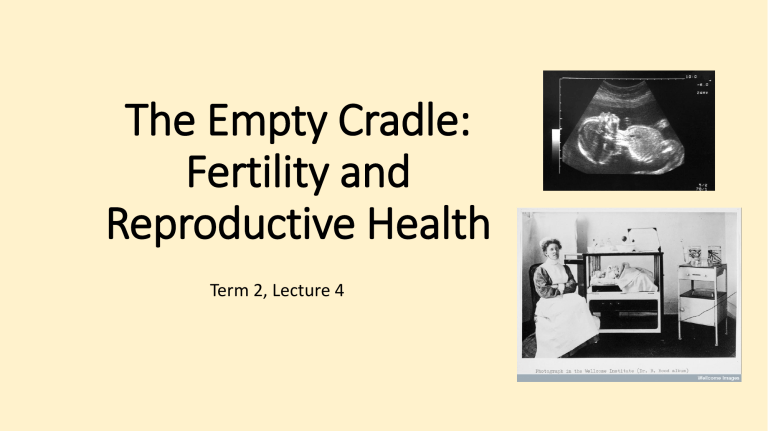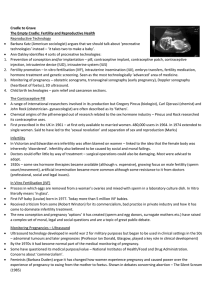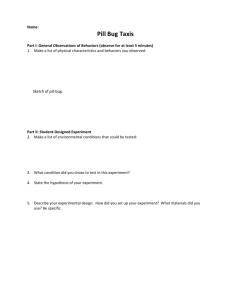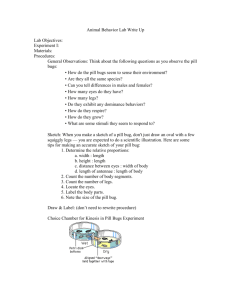The Empty Cradle: Fertility and Reproductive

The Empty Cradle:
Fertility and
Reproductive Health
Term 2, Lecture 4
Lecture Outline
• Reproductive technologies
• Contraception technologies – ‘the pill’
• Infertility
• Conception technologies
• Artificial insemination
• IVF
• Monitoring technologies
The Contraceptive Pill: Development
• ‘Myth’ that it the pill was created by three ‘fathers’ - Gregory Pincus
(biologist), Carl Djerassi (chemist) and John Rock (obstetriciangynaecologist). In fact many people were involved in its creation – international team of researchers.
• Chemical origins came from the growing sex hormone industry c.1920.
• 1939 Russell Marker – professor of organic chemistry at Pennsylvania
State University – developed a method of (cheaply) synthesizing progesterone (from yams)
• In 1951 reproductive physiologist’s Gregory Pincus and Min Chueh
Chang started research on hormonal contraceptive research.
Margaret Sanger (president of planned parenthood) secured funding.
• John Rock (Harvard Professor of Gynaecology) enlisted to investigate the clinical use of progesterone – tested it on his patients with success.
• ‘Envoid’ approved by the FDA in 1962.
The Contraceptive Pill: Social Impact
• By 1966 more than 5 million American women were taking the pill.
• In Britain the pill was first prescribed in 1961. There were
480,000 users by 1964.
• Initially only available to married women. In 1974 family planning clinics were allowed to prescribe the pill to single women.
• Now there are a range of variants on the pill – the combined pill,
IUD’s, patches, implants and the ‘morning after’ pill.
• Pill associated with the ‘sexual revolution’ of the 1960s – separated sex and contraception , and gave women power over their reproduction (Lara Marks).
• Also criticisms from some religious groups/campaigners.
‘"The pill" is a miraculous tablet that contains as little as one thirty-thousandth of an ounce of chemical. It costs 11¢ to manufacture; a month's supply now sells for $2.00 retail. It is little more trouble to take on schedule than a daily vitamin. Yet in a mere six years it has changed and liberated the sex and family life of a large and still growing segment of the U.S.
population: eventually, it promises to do the same for much of the world.’
Time Magazine, April 7 1967
Infertility: Victorian/Edwardian periods
• Women were most frequently ‘blamed’ for infertility – associated with ideas about the inherent ‘weakness’ and ‘sickness’ of the female body.
• Men’s infertility was being identified as an issue by some:
‘Although until comparatively recently it was always assumed that the woman was at fault if the man seemed physically fit for the sexual act, we now know that potential coedundi does not necessarily means potential generandi. It is only in recent years that we have come to learn how much men are to blame for sterile marriages’. The Lancet (1910)
• In Victorian and Edwardian era’s doctors looked to behavioural or social explanations. Also looked visible traits of masculinity/genital abnormalities/mental instability.
• Treatments included behavioural changes and surgical interventions but really little could be done.
‘It is not very uncommon to find that a patient has wandered from doctor to doctor, that one operation after another has been preformed, and that the patient’s pelvis is matted with inflammatory remains, making conception hopeless in any case, while the idea of the husband’s sterility has never been entertained.’ F. Champneys ‘Sterility’ in A system of Gynaecology by
many writer (1906)
• Most couples were advised to adopt.
• Number of adoptions 1927 – 2943; 1939 – 6826; 1946 - 21,280.
‘Jill Wood, a housewife aged 28, was admitted to the care of
Mr Duncan, at the Middlesex Hospital, in 1901, suffering from dysmenorrhea (painful periods) and sterility. Jill had been married for eight years. In the two months prior to her admission to hospital she had been getting very nervous and irritable during her periods, which were regular. On examination under anaesthetic, her cervix was found to look downwards and backwards’.
Middlesex Hospital London: Mr Duncan’s Patients (1901)
Infertility Treatments: 1920-1950
• Some new interest in male infertility – research into male hormones and sperm count/movement – but focus still principally in the female body.
• Growth of research into sex hormones following developments in organic chemistry.
• Sex hormones used to treat menopause, infertility and menstrual problems although prohibitively expensive.
• Artificial insemination also stated to be used as a treatment for infertility – although some resistance from doctors who were uncomfortable with aspects of the procedure (Gayle
Davis).
• Idea and concerns about ‘test tube babies’ and babies by design entered popular culture – A. Huxley, Brave New
World (1931)
Sperm ‘counts’ by
Magnus Gustaf Retzius
(1909)
The departmental Committee on Human Artificial
Insemination (1958) – Feversham Committee
Set up: ‘To enquire into the existing practice of human artificial insemination and its legal consequences; and to consider whether, taking account of the interests of the individuals involved and of society as a whole, any change in the law is necessary or desirable’.
In Vitro Fertilization (IVF)
• IVF is the process by which eggs are removed from your ovaries and mixed with sperm in a laboratory culture dish. Fertilisation takes place in this dish, "in vitro", which means "in glass”.
• First IVF baby was born in Oldham General
Hospital in 1977.
• Today more than 5 million IVF babies have been born.
• Highly commercialised – has raised criticism from some within the profession.
• The new conception and pregnancy ‘options’ it enables have raised a litany of moral, legal and social questions and much public debate.
Professor Robert Winston
‘huge resources are in danger of being squandered on IVF, while just a little more spent on the rest of infertility practice would actually be of far more benefit to our patients.’
‘Women are given drugs to induce ovulation when they ovulate already, much tubal surgery is preformed with instruments more suitable for sharpening pencils, infertile men are fobbed off with drugs which have no proven effect on sperm quality and many women are advised to adopt bizarre coital positions or employ peculiar douches which add unwelcome variety to their sex lives but do little for fertility’.
Leonardo da
Vinci, Sketch-
Books, c. 1510
Hunter, Anatomy of the gravid uterus, 1764
Monitoring technologies: Ultrasounds
• Ultrasounds have changed how we think about foetus – we know information about their sex, age, health, appearance which makes them more like people.
• Ultrasound was developed from technology used to detect submarines in world war 1.
• Initially used to detect tumours – only being used to monitor pregnancy later. Developed for obstetric use by Professor Ian Donald in Glasgow.
• First clinical use in 1966 any by 1970s it had become a normal method of foetal surveillance.
• Its actual medical purpose/value has been questioned by some.
• Feminist critique of how it has led to the devaluation of women’s interests during pregnancy.
Ultrasound in medicine: 1984 report by joint National
Institutes of Health/ Food and Drug Administration panel on the use of ultrasound in pregnancy:
• “no clear benefit from routine use”
• “no improvement in pregnancy outcome”
• no conclusive evidence either of its safety or harm.
Recommendation:
• not for “routine use” or “to view ... or obtain a picture of the fetus” or “for educational or commercial demonstrations without medical benefit to the patient”
• Approved for use to “estimate gestational age”
"Now let's turn to the actual film itself. We are now looking at a sector scan of a real time ultrasound imaging of a 12 week, unborn child. The child is oriented in this direction. You are looking now at the head of the child... here... the body of the child... here.. and this image is the child's hand approaching its mouth. Looking a little more closely at the child, we can discern, the eye or the orbit of the eye, here, the nose of the child, here... and the mouth of the child... here.. and we can even look at the ventricle of the brain, here… Now, we see the heart beating, here in the child's chest …And we can see the child moving rather serenely, in the uterus. One can see it shifting position from time to time. It is still orientated in this manner and the mouth is receiving the thumb of the child.
The child again is moving quietly in its sanctuary.“
Narrative of ‘Silent Scream’ 1985


